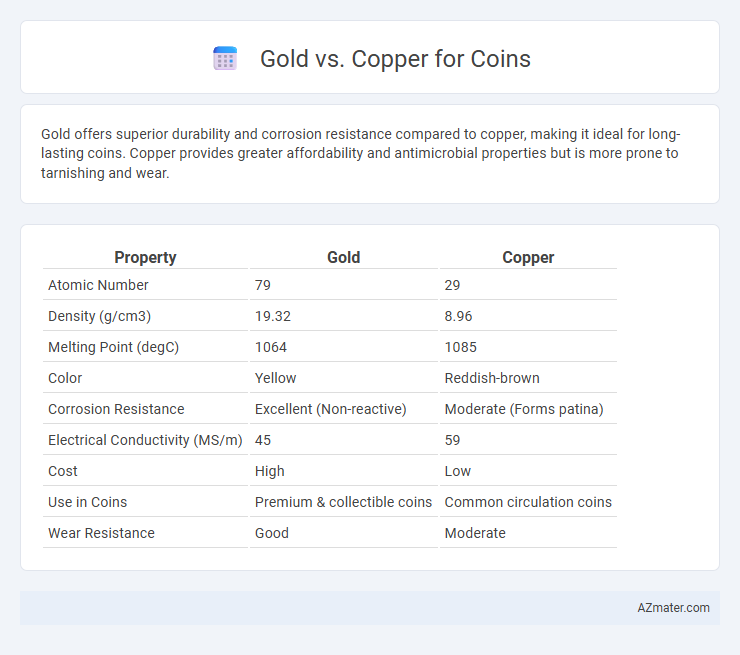Gold offers superior durability and corrosion resistance compared to copper, making it ideal for long-lasting coins. Copper provides greater affordability and antimicrobial properties but is more prone to tarnishing and wear.
Table of Comparison
| Property | Gold | Copper |
|---|---|---|
| Atomic Number | 79 | 29 |
| Density (g/cm3) | 19.32 | 8.96 |
| Melting Point (degC) | 1064 | 1085 |
| Color | Yellow | Reddish-brown |
| Corrosion Resistance | Excellent (Non-reactive) | Moderate (Forms patina) |
| Electrical Conductivity (MS/m) | 45 | 59 |
| Cost | High | Low |
| Use in Coins | Premium & collectible coins | Common circulation coins |
| Wear Resistance | Good | Moderate |
Introduction to Gold and Copper Coins
Gold and copper coins each carry distinct historical and economic significance, reflecting their intrinsic material value and usage in currency systems. Gold coins are prized for their rarity, durability, and high market value, often serving as a store of wealth and investment, while copper coins are more abundant and utilized for everyday transactions due to their lower cost and resistance to corrosion. The metal content influences coin longevity, monetary stability, and collector interest, making gold coins symbols of prestige and copper coins practical mediums of exchange.
Historical Significance of Gold and Copper in Coinage
Gold has been historically prized in coinage for its rarity, durability, and intrinsic value, symbolizing wealth and power across ancient civilizations such as the Roman Empire and medieval Europe. Copper, abundant and more affordable, served as the primary metal for low-denomination coins, facilitating everyday trade and economic accessibility since ancient times in Mesopotamia and continuing into modern economies. The contrasting roles of gold and copper in coinage highlight their essential functions: gold for preserving wealth and copper for enabling widespread commerce.
Physical Properties: Gold vs Copper
Gold exhibits superior malleability and ductility compared to copper, allowing coins to be struck with finer detail and higher durability without cracking. Copper has a higher tensile strength but is more prone to oxidation and corrosion, impacting coin longevity. The density of gold (19.32 g/cm3) is significantly greater than copper (8.96 g/cm3), resulting in heavier and more substantial coins that feel more valuable in hand.
Economic Value and Stability
Gold exhibits higher economic value and greater stability compared to copper, making it a preferred choice for coinage and investment. Its rarity, resistance to corrosion, and long-standing historical acceptance contribute to sustained purchasing power and market confidence. Copper, while more abundant and useful for everyday transactions, lacks the intrinsic value and consistent demand that underpin gold's role as a reliable monetary asset.
Durability and Longevity in Circulation
Gold coins exhibit exceptional durability due to their resistance to corrosion and tarnish, ensuring prolonged elegance and value retention in circulation. Copper, while more prone to oxidation and wear, offers superior hardness that helps maintain detail and reduces deformation over extended use. The choice between gold and copper for coins largely depends on balancing gold's longevity with copper's physical resilience in everyday handling.
Minting Costs and Availability
Gold's high minting costs stem from its density and value, requiring precise equipment to avoid wastage during the coin production process. Copper, being more abundant and less dense, offers significantly lower minting expenses and faster production rates. The widespread availability of copper ensures a steady supply for minting, while gold's scarcity and market volatility can constrain coin issuance and increase costs.
Security Features and Counterfeit Risks
Gold coins offer superior security features due to their intrinsic high value and unique metallurgical properties, making them harder to counterfeit compared to copper coins. Copper coins, being more common and of lower value, are more susceptible to counterfeiting through plating or core substitution techniques. Advanced minting technologies such as micro-engraving and spectral analysis are more frequently applied to gold coinage to enhance authentication and reduce counterfeit risks.
Investment and Collectibility Comparison
Gold coins offer superior investment value due to their intrinsic high market price, liquidity, and historical stability as a store of wealth. Copper coins, while more affordable and popular among collectors for their varied designs and historical significance, generally lack the strong resale value and inflation hedge that gold coins provide. Collectors often prioritize rarity and condition in copper coins, whereas investors focus on gold coins' purity and weight for long-term financial security.
Environmental Impact of Mining and Production
Gold mining generates significantly higher environmental impacts compared to copper, including greater habitat destruction, water pollution, and higher carbon emissions due to its lower ore concentration and complex extraction process. Copper mining, while still resource-intensive, tends to result in less ecological damage and more efficient use of raw materials, leading to a comparatively smaller carbon footprint and reduced water contamination. Sustainable practices and recycling initiatives in copper production further mitigate environmental harm, positioning copper as a more eco-friendly choice for coinage materials.
Conclusion: Choosing Between Gold and Copper Coins
Gold coins offer superior long-term value due to their high intrinsic worth and resistance to corrosion, making them ideal for investment and preservation of wealth. Copper coins, while more affordable and practical for everyday transactions, lack the durability and market value that gold coins possess. Selecting between gold and copper coins depends on whether the priority is investment potential or cost-effective usability in daily commerce.

Infographic: Gold vs Copper for Coin
 azmater.com
azmater.com